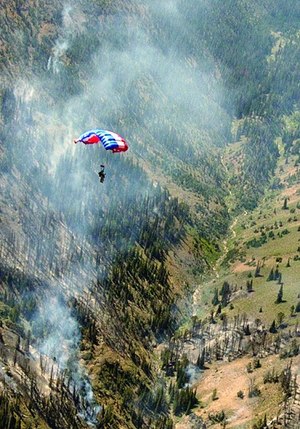how to become a smokejumper
As the "special ops" of wildland firefighting, smokejumpers need extreme skills to succeed in extreme conditions
Most firefighters are eager to finally get their "big one" – but smokejumpers get their "big one" every time the alarm sounds.
Smokejumpers combine skydiving and firefighting, jumping from turbine engines into rampant wildfires in areas not accessible by road. As they jump, winds can propel their parachutes to 20 mph (or more), making landing coordinates nearly impossible to predict. Once they've landed, the job actually begins, fighting a fire sprawling over hundreds of acres without support.
Being a smokejumper is more than a job; it's a lifestyle. Could you hack it in this extreme profession?

1. Are you devoted to the wilderness?
It's not enough to enjoy hiking or an occasional camping trip. Smokejumpers are survivalists. They are the initial force to calm wildland fires in remote areas. Tools, food and water are dropped by parachute to the firefighters after they land, then it's up to each firefighter to be self-sufficient for about 48 hours.
2. Does your experience show you don't mind dirty work?
Going into wildland firefighting requires a special appreciation for nature and dirty work. Apart from needing at least one season of specialized wildland fire suppression work to be considered for the job, smokejumpers need one year of experience to prove skill with hand tools, as well as familiarity with safe work practices. This can include farming, ranching, fire control work, or soil and water conservation activities. It is also essential to know basic first aid procedures.
3. Are you an adrenaline junkie?
Smokejumpers are the "special ops" of firefighters, so it goes without saying that the job is intense. Many don't realize exactly how intense it actually is, though. The job often involves prolonged periods when smoke, heat and short supplies of food and water take their toll.
A smokejumper's parachute can snag on trees as they descend, making for a difficult landing among massive trees in the forest. Douglas firs, common in the Pacific Northwest, can reach around 130 feet. If a parachute gets caught atop a tree, smokejumpers have no choice but to climb down to get to their airdropped equipment.
4. Are you physically fit?
Wildland firefighters train hard, but smokejumpers train harder. Keep in mind that an entry-level smokejumper job is not an entry-level firefighting job, and the U.S. Forest Service physical fitness requirements are intense.
The Office of Personnel Management's (OPM) Qualification Standards for smokejumping are as follows:
- Run 1.5 miles in 10:47 minutes or less
- 6 pull-ups
- 30 push-ups
- Pack 110 pounds on level terrain in 65 minutes or less
There is a maximum of five minutes rest between exercises.
BLM smokejumpers have established target standards based on the BLM Fitness Challenge:
- Run 1.5 miles in 9:30 or run 3 miles in 22:30
- 10 pull-ups
- 60 sit-ups
- 35 push-ups
- Pack 110 pounds on level terrain for 3 miles in 55 minutes or less.
In addition to the basic physical requirements, ongoing training is challenging. Because landing after the jump is so unpredictable, practicing for any situation is imperative. Smokejumping bases have simulators that lift trainees up and drop them at many different speeds (up to 10 mph) so they can learn to land properly.
5. Can you sew?
You wouldn't expect a high-adrenaline career and the art of clothing design to be combined skillsets, but smokejumpers are often responsible for tailoring (inspecting, repairing and making) their own suits. According to the National Interagency Fire Center, smokejumpers have some of the best sewing skills around. Jumpers build their gear and components for the upcoming fire season. They make everything they use, from the jumpsuit to the harness to the backpack.
Even if your lifestyle is a perfect fit for the role, landing a spot in the field is competitive. As of 2021, there were only 320 smokejumpers working from seven USFS bases in the United States. (The BLM also has smokejumpers at two bases in Boise, Idaho and Fairbanks, Alaska.)
About the author
The FireRescue1 Lifestyle content series is written for the off-duty firefighter. Here you'll find content on everything from the latest automotive and entertainment trends to tips and tricks for financial planning – all written from a firefighter's perspective, with an eye toward what makes you unique even when you're not at the station.
how to become a smokejumper
Source: https://www.firerescue1.com/wildfire/articles/how-to-become-a-wildland-smokejumper-qaY6wPxM6PI6AYsE/
Posted by: vargasanich1974.blogspot.com

0 Response to "how to become a smokejumper"
Post a Comment